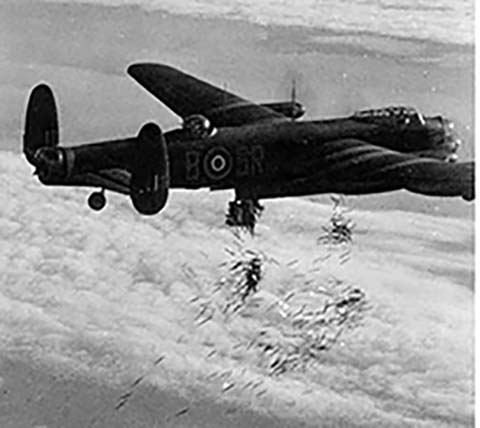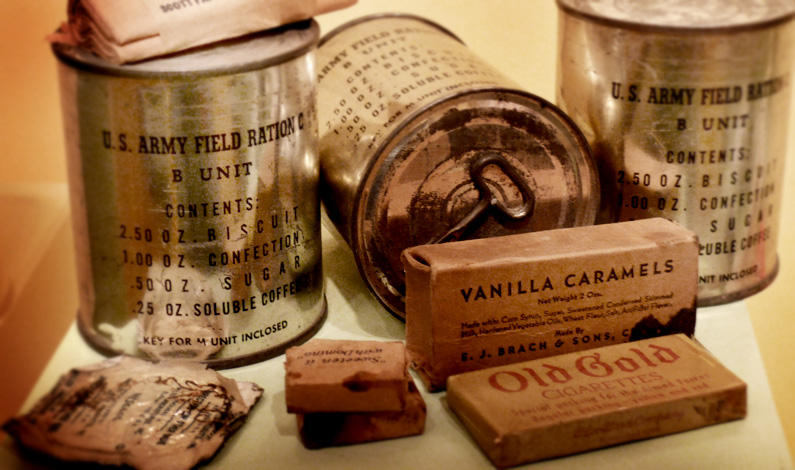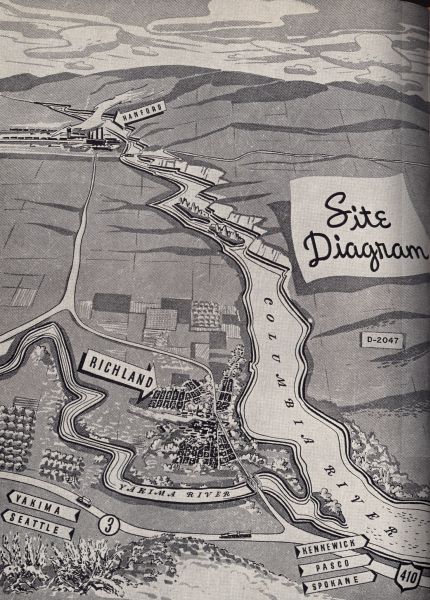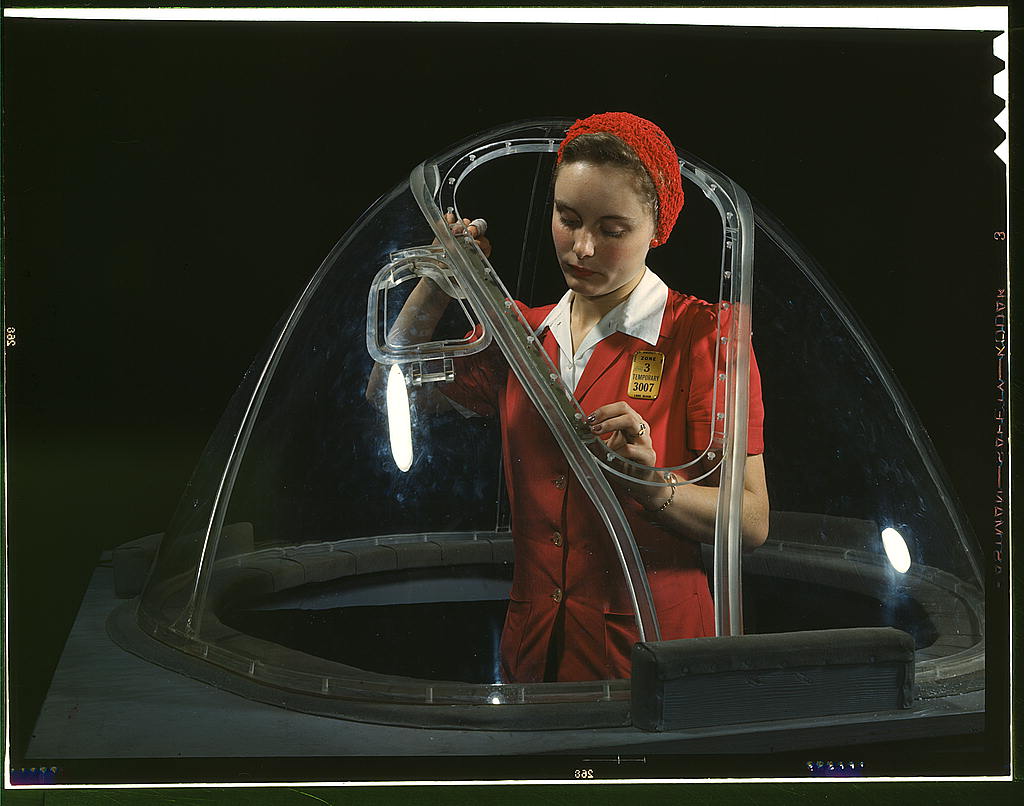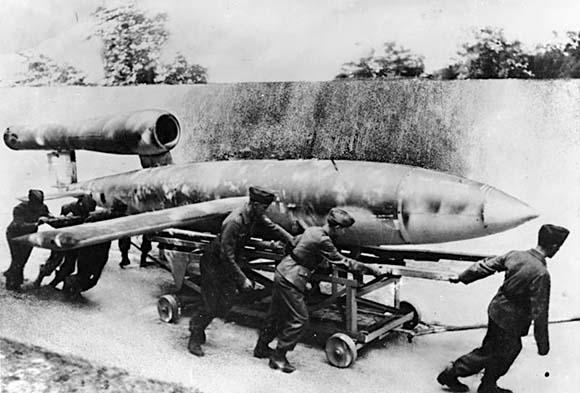For all the role of science, mathematics, and new inventions in earlier wars, no war had as profound an effect on the technologies of our current lives than World War II (1939-45). And no war was as profoundly affected by science, math, and technology than WWII.
We can point to numerous new inventions and scientific principles that emerged during the war. These include advances in rocketry, pioneered by Nazi Germany. The V-1 or "buzz bomb" was an automatic aircraft (today known as a "cruise missile") and the V-2 was a "ballistic missile" that flew into space before falling down on its target (both were rained on London during 1944-45, killing thousands of civilians). The "rocket team" that developed these weapons for Germany were brought to the United States after World War II, settled in Huntsville, Alabama, under their leader Wernher von Braun, and then helped to build the rockets that sent American astronauts into space and to the moon. Electronic computers were developed by the British for breaking the Nazi "Enigma" codes, and by the Americans for calculating ballistics and other battlefield equations. Numerous small "computers"—from hand-held calculating tables made out of cardboard, to mechanical trajectory calculators, to some of the earliest electronic digital computers, could be found in everything from soldiers' pockets to large command and control centers. Early control centers aboard ships and aircraft pioneered the networked, interactive computing that is so central to our lives today.
Seeing Through the Clouds and Beyond
The entire technology of radar, which is the ability to use radio waves to detect objects at a distance, was barely invented at the start of the war but became highly developed in just a few years at sites like the "Radiation Laboratory" at MIT. By allowing people to "see" remotely, at very long distances, radar made the idea of "surprise attack" virtually obsolete and vastly enlarged the arena of modern warfare (today's radars can see potential attackers from thousands of miles away). Radar allowed nations to track incoming air attacks, guided bombers to their targets, and directed anti-aircraft guns toward airplanes flying high above. Researchers not only constructed the radars, but also devised countermeasures: during their bombing raids, Allied bombers dropped thousands of tiny strips of tinfoil, code-named "window" and "chaff" to jam enemy radar.
By constructing complex pieces of electronic equipment that had to be small, rugged, and reliable, radar engineering also set the foundations for modern electronics, especially television. Radar signals could also be used for navigation, as a ship or airplane could measure its distance from several radar beacons to "triangulate" its position. A system for radar navigation, called LORAN (long-range navigation) was the precursor to today's satellite-based GPS technology.
The military found other uses for radar. Meteorologists, for example, could track storms with this new technology—a crucial skill to have when planning major military operations like D-Day. When weapons designers discovered a way to place tiny radar sets onto artillery shells, the proximity fuse was invented. These new fuses would explode when they neared their targets. By the end of the war, proximity fuses had became a critical component in many anti-aircraft shells.
A Real Shot in the Arm
World War II also saw advances in medical technology. Penicillin was not invented during the war, but it was first mass produced during the war, the key to making it available to millions of people (during World War II it was mostly used to treat the venereal diseases gonorrhea and syphilis, which had been the scourge of armies for thousands of years).
While penicillin itself is still used today, it was also the precursor to the antibiotics that we take today to keep simple infections from becoming life-threatening illnesses. Medicines against tropical diseases like malaria also became critical for the United States to fight in tropical climates like the South Pacific. Pesticides like DDT played a critical role in killing mosquitoes (although the environmental impacts of DDT would last a long time; a famous book about DDT, Rachel Carson's Silent Spring (1962), would help found the modern environmental movement). The science and technology of blood transfusions were also perfected during World War II, as was aviation medicine, which allowed people (including us) to fly safely at high altitudes for long periods. Studies of night vision, supplemental oxygen, even crash helmets and safety belts emerged from aviation medicine.
One Word, "plastics"
Chemical labs cooked up a host of new technologies, from new types of explosives to incendiary bombs (including napalm, a form of jellied gasoline heavily used in Vietnam, but first used on the Pacific island of Tinian against the Japanese), flame throwers, and smoke screens. New materials and new uses for old materials appeared as well. Companies manufacturing consumer goods (such as silverware) converted to manufacture military goods (such as surgical instruments). Automobile factories re-tooled to make tanks and airplanes. These industrial modifications required rapid and creative engineering, transportation, and communications solutions. Because of the need to put most resources into the war effort, consumers at home experienced shortages and rationing of many basic items such as rubber, gasoline, paper, and coffee (the country imposed a national "Victory" speed limit of 35 miles per hour to save wear on tires—natural rubber being in short supply since the Japanese had occupied much of Southeast Asia). Consumers had to conserve, or just do with out. Women's skirts were made shorter to save material and bathing suits were made out of two pieces (these later became known as "bikinis," named after an island in the Pacific where the army tested atomic weapons). The 3M company felt compelled to run advertisements apologizing to homemakers for the scarcity of Scotch tape in stores across the country; available supplies of the product had been diverted to the front for the war effort. 3M promised "when victory comes "Scotch" cellulose tape will be back again in your home and office."
New materials emerged to fill these voids; many had been invented just before the war but found wide use during World War II: plastic wrap (trademarked as Saran wrap) became a substitute for aluminum foil for covering food (and was used for covering guns during shipping); cardboard milk and juice containers replaced glass bottles; acrylic sheets were molded into bomber noses and fighter-plane canopies; plywood emerged as a substitute for scarce metals, for everything from the hulls of PT boats to aircraft wings. The look and feel of 1950s America - a "modern" world of molded plywood furniture, fiberglass, plastics, and polyester - had its roots in the materials innovations of World War II.
You Are What You Eat
The science of nutrition expanded greatly during WWII. In the United States, scientists worked to identify which vitamins and minerals were most essential to a healthy body and in what amounts. Studies were conducted to determine how many calories were burned doing various activities. Proper food preparation, storage and handling, and preservation became a top priority for the military. Soldiers' rations were carefully formulated to supply the maximum amount of nutrition and energy, while providing for variety and taste. Meeting these challenges meant working first in the laboratory before working in the kitchen. The development of the D-ration provides a great example. The "D" ration was a high-calorie emergency ration that came in the form of a fortified chocolate bar. A three-portion package of these bars would provide a soldier with 1,800 calories of energy. Once the military settled on a chocolate bar for their emergency ration, scientists set about creating it, with the following requirements: it had to weigh 4 ounces, it had to be high in calories, it had to be able to withstand high temperatures, and it had to taste "a little better than a boiled potato." This last requirement was imposed to keep soldiers from snacking on their emergency rations in non-emergency situations. By the end of the war, millions of these rations had been produced in the United States and delivered around the world, along with billions of other rations for the military.
The Destoyer of Worlds
And of course we're all familiar with the Atomic Bomb, two of which were dropped on Japan to end the Pacific war in 1945. In a pioneering effort, the United States mobilized a massive cadre of scientists, engineers, and industrial plants. Two cities were selected to house processes integral to the bomb's development. Oak Ridge, Tennessee, was surrounded by 59,000 acres of farmland and wilderness. The workers here separated out uranium for the bomb. In Hanford, Washington, the city was chosen for its 500,000 acres of isolated land bordering the Columbia River. Here workers created the new element plutonium. Atomic weapons are so complicated, in terms of the physics, and so difficult to build, in terms of the technology, that two different types of weapons were built, to increase the chances of getting at least one of them right. The bomb dropped on Hiroshima was a uranium-type bomb, and the one dropped on Nagasaki used plutonium.
Scientists in Nazi Germany were working on an atomic bomb as well. But without the huge commitment of resources that the American government offered its scientists, they barely got out of the starting gate. The Atomic Bomb was like radar in that a small number of devices could make a major impact on military operations, so the new invention could have an effect before going into full scale mass production. By contrast, most conventional weapons took so long to mass produce that if they were not at least on the drawing board when the war started they often arrived too late to impact the war. It is notable, however, that the speed with which new weapons systems came on-line, from the drawing board to the factory floor to the battlefield had never before been seen.
New Ideas for a New Age of Warfare
Again, as in earlier eras, perhaps the most profound impacts of World War II were as much great ideas as they were pieces of hardware. Before the war, scientists were professors who ran small laboratories with students, with small amounts of money. Before the war scientists were looking into fundamental principles of the natural world, without much regard for practical applications, and they rarely attracted the attention of national governments. During World War II, science became mobilized on a grand scale; many of these professors and their students dropped everything to work on war-related challenges and initiative. The massive "research and development" (R&D) laboratory emerged in its modern form. The paradigm of these efforts was the "Manhattan Project" which put thousands of physicists together with Army-scaled logistics and designed, built, and manufactured the first atomic bombs. Other laboratories included the so-called "Radiation Laboratory" at MIT which developed radar. Numerous other laboratories focused on everything from electronics to medical research to psychological testing. By the end of the war, the atomic bomb made it clear that science had, in the words of one scientist, "lost its innocence" - that is it was now a critical tool of military power, and was given government money for research at many thousands of times the pre-war levels. Scientists became advisors to presidents on the most pressing issues of national and foreign policy. Ever since World War II, the American government has mobilized science, mathematics, and engineering on a vast scale, whether in large government laboratories, by funding research in universities, or by purchasing high-tech products from companies in industry.
That's Great, But How Do I Use It?
Another critical idea that emerged during the war was "operations research," or OR. Early in the war, some British scientists recognized that a great deal of effort was being put into making new weapons (what they called "developmental research"), but not very much scientific thinking was going into how to use them in complex, real-world military operations (hence "operations research"). A classic problem was hunting Nazi submarines in the Atlantic Ocean that were sinking Allied ships. You only have so many airplanes, and they can only fly for so many miles before they need to refuel. What is the best way to organize the search patterns for these airplanes to have the most likelihood of finding these submarines? Mathematicians got hold of this problem and formulated in mathematical terms, using statistics and probability, which were then solvable for optimal solutions. The new "science" of operations research—applying mathematical principles to flows of materials—was then used on a whole variety of wartime problems, from dropping bombs on enemy cities to calculating the flow of goods through a factory production line. Similar techniques are used today in everything from scheduling airliners to running the "supply chain" at Wal-Mart.
See G.I. Joe Add, Subtract, Calculate Logarithmic Equations
It was not just scientists, mathematicians, and engineers that utilized math and science during WWII. Average soldiers, sailors, airmen, and Marines were regularly called upon to use math and science skills, often newly learned, to accomplish their missions. Taking measurements for firing artillery weapons, reading maps and compasses, determining air speeds and altitudes, setting timers on fuses, these tasks and countless others required a fundamental understanding of many math and science rules. More complicated operations, like navigating an airplane, ship, or submarine, interpreting radar signals, or even fixing a broken tank could require intense and sophisticated training.
Even Army cooks used math. Cooking meals for thousands of men meant using math to formulate amounts of ingredients, determine cooking time, and appropriately plan an effective schedule for getting meals out on time. The average soldier may not have understood how an atom bomb worked—they didn't need to know that—but for day-to-day operations, using math and science skills wisely could make a big difference on the battlefield.
The Darker Side
World War II also saw plenty of disturbing uses of math and science. The Nazi Holocaust, in which 6 million Jews and millions of other people "undesirable" to the German state were murdered, ranks as one of the foulest crimes in human history. Yet the perpetrators saw themselves as anything but primitive barbarians. Nazi race "science" purported to show "scientifically" the superiority of the white "Aryan" race over all other peoples, complete with measurements, classifications, men in white coats, and fancy-sounding scientific theories (later shown to be completely false). When the Nazis formally decided to systematically murder the entire Jewish population of Europe (at the Wannsee conference in 1942), they carried out their malevolent ideas by applying industrial methods borrowed from factories—everything from assembly-line-type organization of killing factories to IBM-punch-card machines keeping track of every last detail. "Mass destruction" instead of "mass production." Even the medical profession, usually the best example of science and compassion in any culture, got into the act by carrying out horrific "experiments" on prisoners of war and civilians. Similarly, Nazi "high tech" weapons of new rockets and buzz bombs were used to attack civilians in a futile attempt to awe them into submission. Had these technologies and techniques and the vast resources put into the Nazi death camps been used to actually fight the war, rather than simply for malicious acts of terror, the Nazis might have stood up more strongly to the U.S. and its allies. The Nazis proved that a "scientific" mindset could well be applied to methods that were themselves mad, but their "rational" approach was undone by their irrational rage.
Good Guys, Bad Guys, Right and Wrong — It's All Here
In conclusion, World War II was the first "high tech war," if we define that modern phrase to mean a war fought with new technologies that were specifically invented for that particular war. The atomic bombs were but the most visible of thousands of small inventions, from materials in the home to training films to new ways of seeing the enemy that contributed to the war effort. The organization of this great war of invention had lasting effects, setting the stage for our "national innovation system" to this day - where the country employs the talents of scientists and engineers to help solve national problems. Moreover, the inventions of World War II can be found in so much of our daily lives, from Saran wrap to computers and large-scale production and shipping of industrial products. Even our education system, the very way we train people to use new technologies, finds some of its origins in World War II. Sometimes it might seem lamentable that so much of our noblest energy - scientific and engineering creativity - goes into humanity's most destructive activities. But like it or not, technology and war continue to be intertwined.
The fields of science and math and the technology that their study produces is not restricted to any one country or side in a war. Scientific and technological progress served both sides in WWII. Both sides poured national resources into developing new and better weapons, materials, techniques for training and fighting, improvements in transportation, medicine, nutrition, and communications. Science and math also know no morality. Alone, they can exist in pure form, devoid of practical use for good or bad. It is only when people apply their actions, desires, intentions to that science and math that they have an opportunity to use them for positive or negative purposes. Each generation of humans can then examine those uses and decide for themselves as a society and as individuals if that science and math was used wisely or not.

